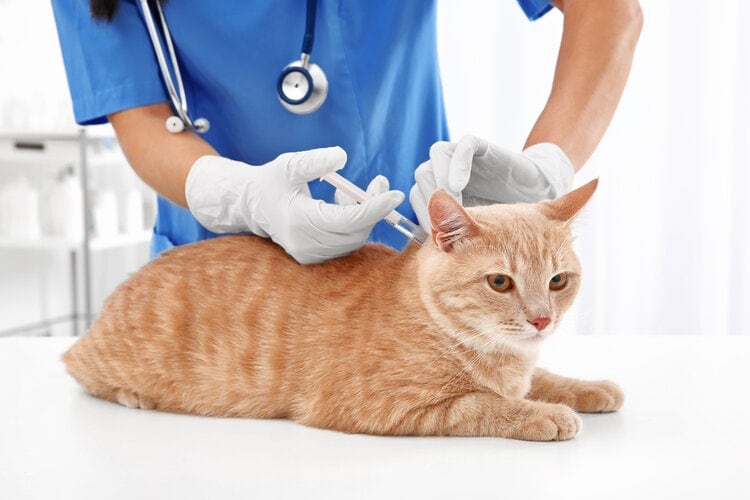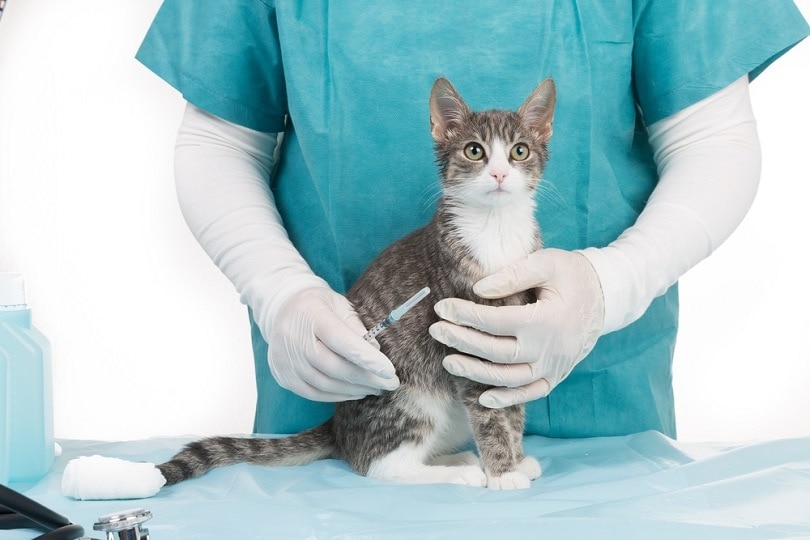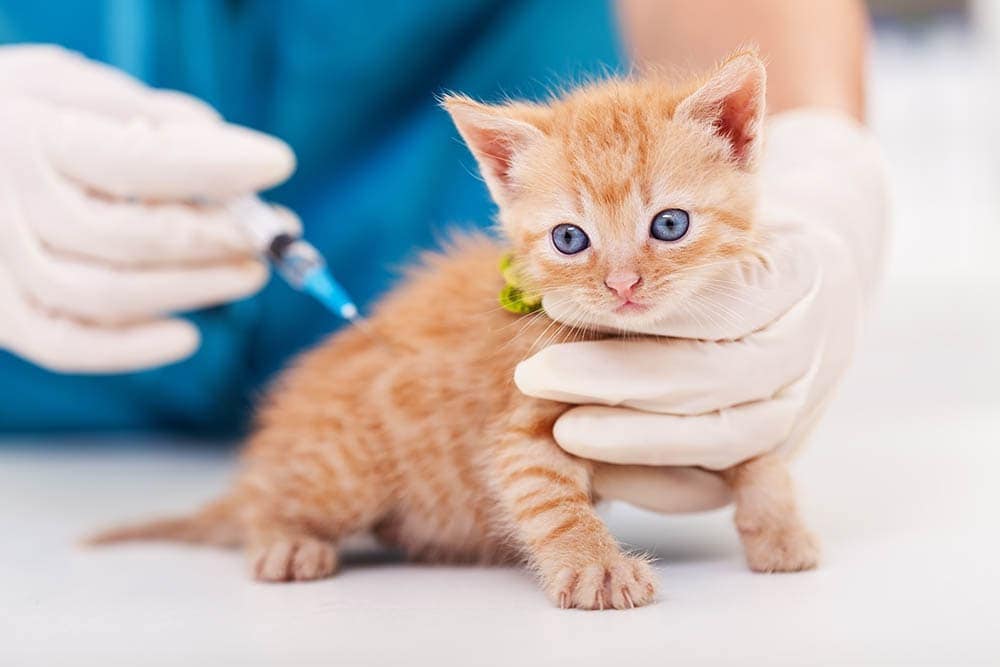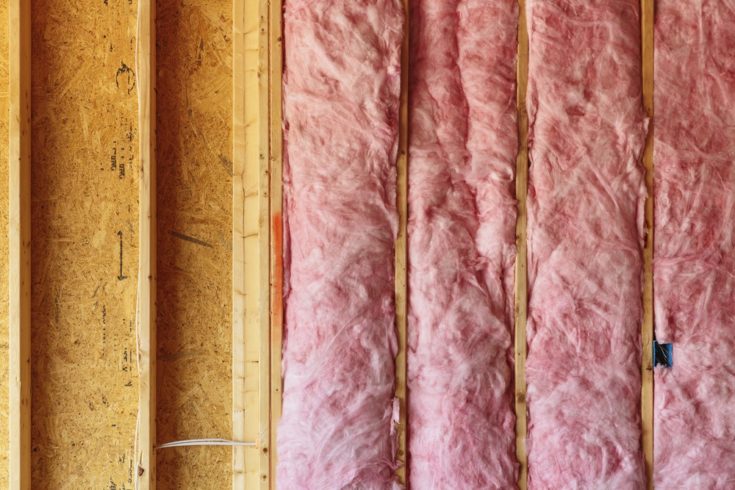What Vaccines Do Indoor Cats Need? Our Vet Answers
By Dr. Leigh Wilder, DVM (Vet)
Updated on

Vaccines are an essential component of feline preventative health care and have the potential to drastically reduce your cat’s risk of infectious disease. But if your cat doesn’t go outdoors, do they still require vaccination? The following guide will discuss why vaccines are needed for indoor cats, as well as the specific vaccines recommended for your indoor-only companion.
Why Vaccinate Indoor Cats?
Indoor cats have a lower risk of contracting disease as opposed to outdoor or free-roaming felines; however, protecting your indoor cat by keeping them up-to-date on vaccines is still recommended. Despite remaining indoors cats may still be exposed to a variety of illnesses, under a wide range of circumstances:
- During travel, boarding, or veterinary visits
- While interacting with other cats
- Through pathogens carried into the home on a pet owner
Your veterinarian will work with you to tailor a vaccination schedule specific to your indoor cat’s needs, based on their health status, life stage, and risk of disease exposure. This schedule will likely align with current recommendations by the American Animal Hospital Association (AAHA) and the American Association of Feline Practitioners (AAFP). According to the AAHA and AAFP, indoor cats should receive the following core vaccines:
- Rabies
- Feline Panleukopenia + Feline Herpesvirus-1 + Feline Calicivirus
- Feline Leukemia Virus (kittens)
Vaccinations are important to keep your pet happy and healthy but some of them can be very costly, especially if you have more than one pet. A customized pet insurance plan from Spot may be able to help you manage your pet's vaccination and healthcare costs.

The Vaccines That Indoor Cats Need
1. Rabies
Rabies is a fatal, zoonotic (transmissible from animals to humans) viral disease affecting the nervous system of mammals. Transmission most often occurs through the bite of an infected animal, from direct contact with saliva containing the virus. Both furious and paralytic forms of the disease can be seen, with the furious form being more commonly-noted in cats. Symptoms associated with rabies in felines may include uncharacteristic aggression, hyperexcitability, seizures, excess salivation, an inability to swallow, and progressive paralysis. Death from the virus typically occurs within 10 days of the onset of clinical signs.
Keeping your feline up-to-date on their rabies vaccine is extremely important, as cats are the domestic animal most commonly reported to have rabies in the United States. Indoor cats may be exposed to rabies through contact with wildlife if they escape their home. Additionally, transmission may occur if wildlife (such as bats) are able to gain access to the home and have contact with a curious feline.
The rabies vaccine is first administered to kittens 12 weeks of age or older. Cats should then be revaccinated 1 year after their initial vaccine. Additional booster vaccines are administered every 1–3 years depending on the specific vaccine used.
2. Feline Panleukopenia + Feline Herpesvirus-1 + Feline Calicivirus
Feline Panleukopenia (FPV), Feline Herpesvirus-1 (FHV-1), and Feline Calicivirus (FCV) are a trio of diseases with the potential to cause serious illness in affected felines:
- FPV: FPV is a very contagious and often fatal viral illness shed in the urine, stool, and nasal secretions of infected cats. FPV can be spread by direct contact with infected individuals, or via contact with contaminated bedding, cages, food bowls, or clothing. The virus is hardy, can survive for periods of up to one year in the environment. Symptoms of FPV include anorexia, depression, fever, vomiting, diarrhea, and dehydration.
- FHV-1: FHV-1, also known as feline viral rhinotracheitis, can cause severe respiratory tract disease characterized by fever, rhinitis (inflammation of the lining of the nose), sneezing, and conjunctivitis. Transmission of the virus occurs via contact with infectious ocular, oral, or nasal secretions as well as through environmental contamination. Symptoms from FHV-1 infection may last anywhere between 1-6 weeks and are often compounded by secondary bacterial infections. After a cat has recovered from infection with FHV-1, the virus remains present in its body and may reactivate and cause flares of illness during times of stress.
- FCV: Similar to FHV-1, cats with FCV may experience fever, nasal and ocular inflammation, and depression. Oral ulceration and subsequent poor appetite may also be noted in affected felines. The mode of FCV transmission is also similar to FHV-1, however, FCV may persist longer in the environment. Symptoms of FCV last 7–10 days on average.
Protection from FPV, FHV-1, and FCV is most often accomplished in a combination vaccine. The vaccination schedule for both inactivated and attenuated live parenteral FPV + FHV-1 + FCV vaccines involves initial vaccination no earlier than 6 weeks, and then every 3–4 weeks until 16–20 weeks of age. Kittens greater than 16 weeks of age at initial vaccination should receive either one or two doses of a combination vaccine 3–4 weeks apart.
Revaccination should occur 6 months to 1 year after initial vaccination, with subsequent booster vaccines administered every 3 years. While this schedule is recommended for the types of combination vaccines noted above, it is important to note that there are different types of vaccines available. Your veterinarian will follow the label instructions of the specific product that they use when deciding on a vaccine schedule.

3. Feline Leukemia Virus (Kittens)
Feline Leukemia Virus (FeLV) is a common infectious disease of cats, affecting 2–3% of cats in the United States. The FeLV retrovirus is transmitted through close contact with other felines and is most commonly spread in the saliva of infected cats. Symptoms of FeLV include weight loss, fever, lethargy, diarrhea, and inappetence.
FeLV vaccination is recommended for indoor kittens as they are at a higher risk for progressive infection, rapid progression of illness, and death from the disease as opposed to adult cats. Additionally, a kitten’s lifestyle and risk factors affecting disease susceptibility may change throughout their first year of life; making the protection offered by vaccination important.
According to AAFP and AAHA guidelines, kittens greater than 8 weeks of age should receive two doses of the FeLV vaccine administered 3–4 weeks apart. Cats are then re-vaccinated 12 months after the last dose in the series. Additional vaccine boosters may be considered either annually or every 2–3 years depending on a cat’s specific level of risk and the vaccine product used. An indoor-only cat living either alone, or with a small number of other FeLV-negative cats, for example, would be considered low-risk for FeLV and would likely not require vaccination.
Conclusion
Vaccinating your indoor cat will help to keep them healthy and minimize their risk of suffering from preventable illness. While there is no “one size fits all” philosophy regarding feline vaccines, the recommendations of the AAHA and AAFP discussed above provide guidance on vaccination for indoor-only cats. Rabies, FPV, FHV1, FCV, and FeLV (kittens) vaccines are recommended as core vaccines to protect cats and kittens from diseases with the ability to cause significant disease and death in feline populations. Through a discussion of these guidelines and partnership with your veterinarian, you will be able to positively impact your pet’s health for many years to come!
Featured Image Credit: Africa Studio, Shutterstock














